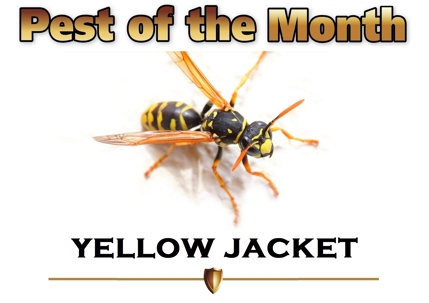It’s a sunny afternoon in Providence, and you’re outside when you notice something unusual—yellow and black streaks buzzing around a small hole in your yard or near the corner of your shed. A closer look confirms your suspicion: you have a yellow jacket nest on your property.
Understandably, your first instinct might be to grab a can of spray or try to block the entrance. After all, how hard can it be to deal with a few wasps? Taking on a yellow jacket nest alone is not only risky, but it’s often ineffective and can worsen the problem.
At Guardian Pest Control, we’ve witnessed the consequences of DIY attempts across Providence. From painful stings to property damage, these issues are often preventable with professional help.
If you find yellow jackets nesting near your home or business, call our team at (401) 812-3033 or contact us online to schedule a safe, professional inspection.
The Real Dangers of Yellow Jackets
Yellow jackets aren’t just your typical backyard nuisance. They are among the most aggressive stinging insects, especially from late spring to early fall. These wasps are highly territorial and will fiercely defend their nests from any threat, including humans and pets.
Unlike honeybees, which can sting only once, yellow jackets can sting multiple times. Their venom can cause intense pain, swelling, and—more seriously—severe allergic reactions such as anaphylaxis. These reactions can occur suddenly, even in people with no known allergies. Symptoms like difficulty breathing, dizziness, hives, and swelling of the face or throat should be treated as medical emergencies.
Their ability to coordinate attacks makes yellow jackets even more dangerous. When threatened, they release a pheromone that attracts other yellow jackets to swarm and sting. The danger rises quickly, especially when nests are large, often by mid- to late summer. A mature nest can house thousands of wasps.
Even worse, many nests are hidden from sight. Ground nests are often placed in abandoned rodent burrows, while aerial nests could be concealed inside walls, attics, or behind siding. Their hidden locations make them hard to find and greatly increase the risk when attempting to remove them.
It’s also easy to confuse them. Yellow jackets are shiny, hairless, and have bright black and yellow stripes, which set them apart from bees, which are rounder and fuzzy. Other wasps, such as paper wasps or hornets, might look similar but tend to act less aggressively and build different types of nests. Knowing the difference is crucial for safe and effective treatment.
Why DIY Nest Removal Isn’t a Good Idea
While trying to remove a yellow jacket nest on your own may seem like a fast and cheap solution, it often results in pain, frustration, and additional costs.
Increased Risk of Stings
Approaching a nest without protective gear and the proper tools almost always ends badly. Yellow jackets react immediately to vibrations and movement near their nest. If you disturb it by spraying, covering, or bumping it, you're likely to be swarmed and stung.
DIY Methods Often Fail to Work
Most over-the-counter sprays only kill the yellow jackets on the surface, leaving the queen and deeper layers of the colony untouched. The nest rebounds within days.
Pouring liquids, like water or soapy water, into a nest might drown a few wasps, but mostly provokes aggression. It rarely reaches the queen or all the workers.
Sealing up the entry hole doesn’t destroy the nest. It forces the yellow jackets to find a new way out, sometimes into your home’s interior.
Unseen Dangers
Attempting to tackle a yellow jacket nest yourself has dangers other than those posed by the insect.
Possible risks include:
- Ladder accidents – Many nests are high up under eaves or on second-story structures. Attempting removal from a ladder while dodging angry wasps is a recipe for injury.
- Confined spaces – Nests inside walls, crawl spaces, or sheds can trap you with swarming wasps if you’re not trained or prepared to exit quickly.
- Risk to others – A stirred-up nest doesn’t stay contained. When yellow jackets become aggressive, pets, children, and neighbors can become unintended victims.
Potential Property Damage
If a nest is built into your wall, attic, or insulation, improper removal can damage drywall, siding, or wiring. Worse, yellow jackets may chew through interior materials trying to escape, leading them directly into your living space.
How a Pest Control Company Safely Handles Yellow Jacket Nests
When you hire a pest control company, you get an experienced team of exterminators trained to handle high-risk infestations safely and effectively.
The benefits of having an exterminator target a yellow jacket nest include:
- Professional safety measures – Technicians have industry-grade protective gear and specialized equipment to neutralize nests without provoking an aggressive swarm. Their protocols focus on minimizing risk while maximizing results.
- In-depth knowledge – Technicians know where and how yellow jackets build their nests, even in hidden or hard-to-reach spots. They evaluate the visible activity and look for secondary nests or signs of colony expansion. By understanding yellow jacket behavior, an exterminator implements treatments to target their patterns and interrupt their life cycle.
- Complete colony targeting – Professional treatments target the core of the colony and treat the queen, destroying the nest and stopping regrowth.
- Long-term prevention – Professionals can advise on long-term prevention strategies. They may also offer follow-up inspections to protect your property from yellow jackets.
Let the Professionals Handle the Sting
Yellow jacket nests pose serious health, safety, and property risks. While DIY removal might seem tempting, it usually doesn't fix the problem and can put you and your loved ones in danger.
Instead, take the safer path. Trust our experienced team at Guardian Pest Control for effective yellow jacket nest removal in Providence, RI. Call (401) 812-3033 or contact us online to schedule an inspection.

